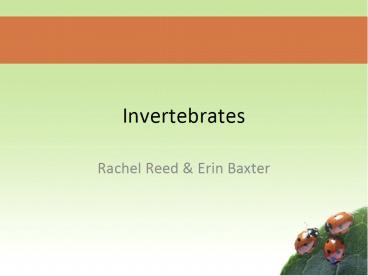Invertebrates - PowerPoint PPT Presentation
Title:
Invertebrates
Description:
Invertebrates. Rachel Reed & Erin Baxter. Importance. 95-99% of all ... Diet: mix of live and dead invertebrates, dead pinky mice, day old chicks, adult ... – PowerPoint PPT presentation
Number of Views:615
Avg rating:3.0/5.0
Title: Invertebrates
1
Invertebrates
- Rachel Reed Erin Baxter
2
Importance
- 95-99 of all species
- Pollination
- Recycling
- Food in many cultures
- Food webs
- Maintenance of ecological communities
3
E.O. Wilson
- If human beings were not so impressed by size
alone, they would consider an ant more wonderful
than a rhinoceros.
4
Basics
- Aquatic vs. Terrestrial
- Arboreal, aerial
- Anatomical Definitions
- Hemolymph, exoskeleton, hydrostatic skeleton
- Reproductive terms
- Dioecious, hermaphroditic, parthenogenesis
5
Considerations in Aquatic Care
- Marine vs. Freshwater
- Water quality
- Substrate, plants
- Light
- Water circulation
- Other species in aquaria
- Diet
6
Considerations in Terrestrial Care
- Safe, sanitary, not crowded
- Temperature considerations
- Substrate, plants
- Water availability mode of delivery
- Arboreal species?
- Air circulation
- Diet
7
(No Transcript)
8
Ctenophora Comb Jellies
- Marine waters
- Carnivorous Diet
- Water requirements dependent on species
- Most are hermaphroditic
- Water Flow patterns are important
9
Phylogeny
10
Porifera Sponges
- Primarily Marine sessile
- Water requirements dependent on species
- Unique feeding system tiny pores water flow
necessary - Reproduce by both sexual and asexual means
11
Phylogeny
12
Cnidaria
Anemones
Jellyfish
Radial symmetry,Hydrostatic skeleton, Dimorphic
development
Can sting!
Coral
13
Anemones
- Marine
- Need excellent water condition
- Most capture animal prey zooanthellae
- Variable but specific temperature requirements
dependent upon species - Asexual reproduction
- Interspecific Aggression
14
Jellyfish
- Marine
- Water flow patterns
- Predators have stingers!
- Sexual reproduction
- Lots of species variability
15
Coral
- Marine
- Water Quality Important!
- Zooxanthellae Most capture animal prey
- Sexual Asexual Reproduction
- Can exhibit contact inhibition and interspecific
aggression in the tank - Hermatypic vs Ahermatypic
16
Phylogeny
17
Echinoderms
- Marine
- Water quality important- toxicity problems
- Diet is largely dependent on species
- Asexual sexual reproduction dependent on
species - Water vascular system ?locomotion, gripping,
feeding
http//www.studentreader.com/files/purplestarfisho
nrocks.jpg
18
Phylogeny
19
Sea Squirts
- Sessile, marine
- Environmental management based on species
- Herbivorous diet
- Sexual or Asexual reproduction
- 90 of all urochordates
http//www.lancashiremcs.org.uk/gallery/pics/sea-s
quirt.jpg
20
(No Transcript)
21
Gastropods
- Marine freshwater
- Sessile and mobile
- Filter feeders
- Tank Management
- Substrate
- Dioecious or hermaphroditic
http//jrscience.wcp.muohio.edu/photos/SeagrassMol
luscs.jpeg
22
Cephalopods
- Marine Aquatic
- Varied diet
- Active hunters
- Tank Management
- Dioecious
http//www.aquariumofpacific.org/images/olc/nautil
usj.baecker_berlin_zoo_aquarium_pd600.jpg
23
Phylogeny
24
Pogonophora Vestimentifera
- Deep sea dwelling worms!
- Often grouped together
www.ucmp.berkeley.edu
www.nsf.gov
25
Phylogeny
26
Annelids
- Aquatic and terrestrial
- Varied diet and feeding strategies
- Environmental requirements dependent upon
species - Sexual reproduction dioecious
- Biomedical ecological importance
http//www.education.umd.edu/blt/pic/Annelids.jpg
27
Phylogeny
28
Rotifers
- Most freshwater but some
- marine and terrestrial
- Omnivores
- Water Management
- Parthenogenic or dioecious
29
Phylogeny
30
Flatworms (Turbellarians)
- Mostly Aquatic
- Varied diet
- Commensal and parasitic
- Tank Management
- Varied reproduction
http//www.dhadm.com/wp-content/uploads/2008/03/fl
atworm02.jpg
31
(No Transcript)
32
Nematodes
- Aquatic Marine
- Varied diet
- Mostly parasitic
- Environment Management
- Dieocious or parthenogenic
http//soils.usda.gov/sqi/concepts/soil_biology/im
ages/large_todes_LR.jpg
33
Phylogeny
34
Tardigrades
- Marine, freshwater
- terrestrial
- Water bears
- Cryptobiosis
http//www.uea.ac.uk/b444219/images/TNWP_Echinisc
us20madonnae20(SEM).jpg
35
Phylogeny
36
Onychophora
- Tropical, terrestrial
- Velvet worms or walking worms
- Prey on smaller arthropods
37
Phylogeny
38
Crustaceans
- Terrestrial and Aquatic
- Diet dependent on species
- Tank Management
- Dieocious
- Economic importance
www.britannica.com/eb/art/print?id104965
39
Phylogeny
40
Insects
- Predominantly terrestrial
- Varied Diet
- Environmental Management
- Reproduction
- Social Systems
- Economical Ecological Importance
41
Phylogeny
42
Myriapods
- Terrestrial
- Diet dependent on species
- Well defined environmental requirements
- Dieocious some parthenogenic
43
Myriapods
- Millipedes
- Mostly herbivorous
- Two pairs per body segment
- Non-aggressive slow
- Easy to handle
- Centipedes
- Mostly carnivorous
- One pair of legs per body segment
- Aggressive fast!
- Extremely hard to handle venomous
http//cordially.narod.ru/album/insect/images/home
-centipede.jpg
http//www.garden-city.org/zoo/animalinfo/images/m
ilipede_76pic.jpg
44
Millipedes
- Substrate 8-10cm of soil with
- 3-4cm of leaf litter on top
- Temperature
- Humidity
- Diet leaf litter, fruits vegetables
- Reproduction
45
Centipedes
- Soil covered with leaf litter or mulch
- Temperature
- Humidity
- Light
- Diet mix of live and dead invertebrates, dead
pinky mice, day old chicks, adult mice, etc. - Reproduction
46
Phylogeny
47
Horseshoe Crabs
- Marine, Aquatic
- Captive diet
- Various habitats
- Dieocious
- Limulus amebocyte lysate (LAL) extracted from
hemolymph- Pharmaceutical use
http//io.uwinnipeg.ca/simmons/16cm05/1116/33-28-
HorseshoeCrabs.jpg
48
Phylogeny
SPIDERS!
49
Arachnids
50
Scorpions
- Terrestrial
- Carnivorous
- Environment mostly desert
- Sexual reproduction
51
Spiders
- Aquatic terrestrial
- Carnivores
- Diverse Environments
- Sexual Reproduction
- Silk!
52
Terrestrial Spiders
- Arboreal vs. Non-arboreal
- Diet
- Substrate
- Temperature humidity
- Lighting
53
Aquatic Spiders
- Natural environment
- Diet
- Water Quality
- Underwater air bells
54
Silk
- Made of Amino Acids
- Very stable
- Very Strong
- Genetic Isolation
- Production
- Application
55
Resources
- Lewbart, Gregory (ed.). 2006. Invertebrate
Medicine.Blackwell Publishing, Ames, Iowa. - Frye, Fredric L. 1992. Captive Invertebrates.
Krieger Publishing Company, Malabar, Florida. - Pechenik, Jan A. 2000. Biology of the
Invertebrates. McGraw-Hill. 5th ed is 2005.































